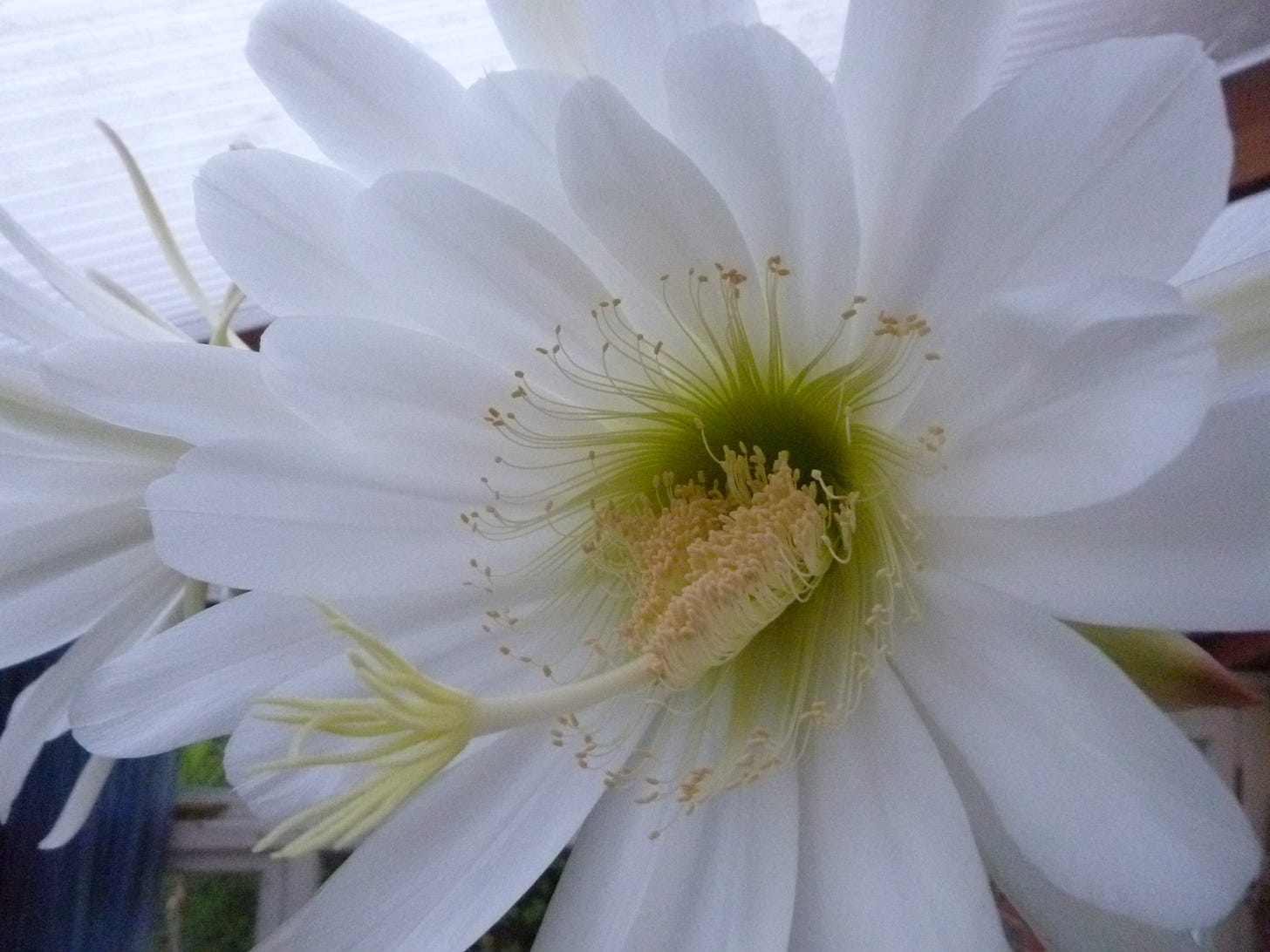
I am standing on the veranda of a palm-leaf cabana in Vilcabamba, Southern Ecuador, 1992, coffee beans drying at my feet.
I am sitting beside a flowering cactus in a polytunnel in Darsham, Suffolk. 2023, a thermos of coffee in my hand.
The bridge that arcs across these 30 years is this cactus. It’s called San Pedro, and the one I sit with has been with us for the last two decades. I found it in a head shop in Ipswich. It was ten inches high in a small pot. It is now two 10-foot columns with several ‘pups’ and roots that have invisibly extended beyond its large pot confines. When we had to move three years ago, our new cottage had no conservatory, so it flourishes here in Malcolm’s polytunnel among the brassicas and peas, and every week when we collect our veg box, we come and visit it. Like the cactus, we’ve known Malcolm since we came and put our own roots down in the sand and clay of East Anglia.
Now, in early July, the cactus has unfurled nine flowers like white trumpets, which even balancing on a stepladder, are almost impossible to reach. Occasionally their incomparable scent drifts down. San Pedro flowers once a year, at night, summoning its native pollinators (hummingbirds, moths and bats) towards its fragrant golden core. So, in another country, in place of those winged creatures, I get on my bike at dawn and make a pilgrimage. It’s quiet and peaceful sitting here, Just the blackbirds and thrushes singing, myself, the plant.
‘Is there anything I need to know? I ask.
‘Mesa’ was the word that jumped into my head.
Mesa! I hadn’t thought about that word for decades. But as soon as it came, the idea for this series began. Like the four winds, I first encountered the mesa in this columnar cactus’ homeland, the foothills of the Andes, in a valley where a condor wheels over the peaks that look like a man’s face gazing up at the stars,
San Pedro is a medicine plant, and has been used by curanderos for thousands of years to see into the bodies of their patients. In the 90s seekers and travellers came to this place, Madre Tierra, to take the bitter cordial made from its flesh, mixed with other herbs and flowers. After a revelatory day, Mark and I will leave our hermetic cabana and descend the hill for the communal supper, and be shocked to find we can see into people’s bodies as if they were made of glass. People who looked out of alignment and disfigured, not from personal experience, but from the wars and traumas of European history they had inherited. as both its victims and its victors.
So though most of the people who walked through the sugar cane fields, flickering with fireflies, came to Madre Tierra for a good time, to take San Pedro and see with unveiled eyes the beauty of the sacred valley, some of them came unwittingly for a deeper reveal; to find themselves afterwards facing another direction, without a culture that might back such existential encounters and make sense of them. These seismic shifts left some on a perpetual journey, searching to recapture that Edenic way of beholding the Earth, others trying to rescue lost souls from the Underworld –small town saviours and shamans, falling into all kinds of nightmare not of their making. But mostly, they forgot entirely what the plant, the mountain, the valley, was telling them all the time: it is here, it is here.
Until the wind changes again one summer’s morning, and you find yourself remembering.

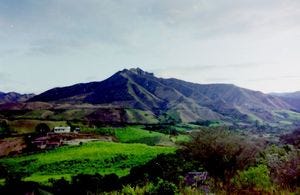
Building a Mesa
I’m not a medicine person, nor a healer, but I have learned over these years how to see in depth and time. Even though we are separated by time and living far from mountains, everything I experienced in that valley in those years is pin-sharp in my memory. The essence of what the place, the plant, transmitted there is still with me.
The medicine people of these foothills work with what they call a mesa (table or altar), where they lay out the ‘tools’ of their trade. These might take different forms from shells to tobacco to feathers. These are physical mnemonics that act as keys to enter and negotiate with the invisible worlds: the shadow realms where the forgotten and damaged parts of our selves roam, and the curanderos’ non-human helpers and intermediaries that bring those parts back into alignment.
When we returned from travelling, I brought with me a Taramuhara woven basket where I kept stones and shells and seeds from the places I had been and put these treasures on the windowsill and writing table. A sort of messy haphazard mesa if you like. After my early morning visit to the San Pedro I thought I could start this Substack series with a more formally curated table of ‘objects’ that have acted as portals over the years, keyholes into places and times, where I interacted with the beings there and maintained a connection.
a piece of malachite, a swan feather, a pod of orange coral beans, a deer skull
I would choose some of these to write about how they work and how you can make your own mesa and connect the experiences a portal might bring, as part of a practice of expanding of space and time as mentioned in the series’ introduction. Unlike the rational mind which thinks in a linear sequence of events, so what is past is past, and no longer ‘living’, the imagination works in a non-linear way, in the spaces in between things, and is always lively. It works like a mycelium underground always connecting and diverging, making contact with other lifeforms, nourishing the roots of our beings.
The trick is in establishing the right set and setting, the right frame of mind and heart, for this metaphysical practice. What is sometimes known as ground state calibration. Finding the fundamental ground of your being, deciding to make time to sit by a plant, or in the doorway of a red tent, to pay attention.
Portals
Over these past years, I’ve been teaching collaborative writing and Earth connection with fellow writers and activists, and we have used the portal as a speaking tool for people to introduce, not just themselves, but the land and the beings of their local territories. Working with the denizens of places – creatures, winds, waterways, plants, ancestors – the portal acts as a springboard to communicate those explorations.
I’ve used my own mesa for telling stories about perception: a flint from the cliffs of Eastern Bavents to show how to access deep time, a wooden raven with the sun in its beak to tell an ancestral tale about the stealing of fire. The portal acts as a focus for deep attention that can go beyond the busy superficiality of the everyday gaze. It captivates what we call the self-obsessed left-hemisphere focus, so the right-hemisphere imagination can reveal the riches of its memory and resonant relationships with other beings in time.
I’ve used a stone from Ecuador to tell the story of the first circle I made, to talk about the capacity stones have to retain memory, to map out a configuration that lasts through time. It comes from a beach called Alanduluz by the Pacific Ocean, where a small collection of leafy cabanas and hammocks face the sea: an extraordinary beach filled with blue stones, where pelicans fly past, skimming the waves.
Here is a drawing from a notebook I made at the time, after I came from the mountains to the coast. I found myself dancing the eight directions and I marked them with those many coloured stones. This blue-green stone is at the North East. I am not South American, I am not initiated into any tribe or tradition, I have no human teachers in these ways of seeing. But the lands I travelled to, the creatures, rocks, and plants of these places, came to me and showed me their medicines, how to look into the dreaming fabric of the Earth. And sometimes the people gave me a gift, or visited in a dream and told me things. Sometimes I found my feet on a beach and danced a pattern, or drew a shape on the page, a circle that made sense of what I was exploring in those South wind times. Now looking back, these shapes in my notebooks still makes sense, though the words feel outdated, though the condor is now a buzzard and the pebbles on the beach are grey and brown. Much of the language has faded from my lexicon, but the stones that remain hold a certain resonance. The portals on a mesa are still lively after all those years. Those lively portals are keys.
What doors those keys open, where they take you, is hard to capture in words. For years, I did try to capture it in all forms of writings and performance, and later in teaching. Then I realised it was a practice I could share. A practice in bending the curve of linear time, a practice of thickening the correspondences between places and people, locating your own being in time and space, within a deliberately skewed system of deracination and mechanical time. Something done regularly to keep the imagination in shape, alive, fired up, connected, in the same way a violin player will keep their fingers nimble to access the music, or a dancer stretch their legs to connect with the dance.
And most of all to know it is not a solo act when we practice.
Because these portals you keep on a mesa are not strictly ‘yours’, they are shared knowledge. The mesa is a co-created thing. It is an ancestral tool that is remembered via an ancestral plant, a hallucinogenic cactus called San Pedro, keeper of the keys, given to anyone who can undertake this work. Unlike the constructed human world, the planet doesn’t care who you are or where you are from, whether you are qualified, worthy or enlightened. It will speak, give you knowledge, if you are open. If you can take time to open your eyes and let the place where you are reveal itself. That’s what I wanted to say. If you find a portal on your windowsill, or shelf – a stone, a bone, a seed – hold it in your hand, go out into the morning, look up into the sky.
Where does it take you? What do you remember?
Feel your feet and open your imagination, going from where you are here now to where you were then. Hold both times in your heart. Breathe.
Who is standing by you?
SHELF
In each of these posts I plan to share texts or artwork where a tool or phrase used in this series originated. GROUND STATE CALIBRATION is a term from the great three-tiered work, Pharmako, by the Californian ethnobotany explorer and metaphysician Dale Pendell. If you haven’t come across his work and are a self-confessed ‘plant person’ or have done some voyaging in the company of medicine plans these books are for you. Visionary, detailed, baffling, funny, poetic and intensely metaphysical, it is a worthy companion for any grounded alchemical journey. As Gary Snyder says in his introduction to the first volume Pharmako Poeia: ‘It may not be for everyone – but neither is mountaineering’.
Ground state training is all about discipline and attention. This is a skill we share with hunters – like cats, and maybe frogs. It is simply the power to focus on something you wish, without becoming lost in internal dialog or fantasy. What could be simpler, more useful, or fundamental? In ancient times, the skill of attention was used to master swordsmanship, or archery, or painting. This is still true today.
A chapter on San Pedro appears in the second volume, Pharmako Gnosis under the section Phantastica, visionary plants.
COMING UP!
This time next week the Dark Mountain Project will be launching our next special issue Eight Fires which is focused on creating and responding to a collective land-based practice, and includes some of the tools I will be discussing in The Red Tent. Based on the Dark Mountain workshop series ‘How We Walk Through the Fire’, the book gathers round the eight ceremonial fires of the year, If you are keen to engage in this creative practice with others, I’ll be hosting four sessions with fellow Dark Mountain ‘guides’ this December. All details here:
Thanks for reading everyone and hope to see you again soon.
If you would like to read further about San Pedro and working with plants, you can find more in my book 52 Flowers That Shook My World (PDF). Paid subscribers are welcome to a free copy if they sign up.





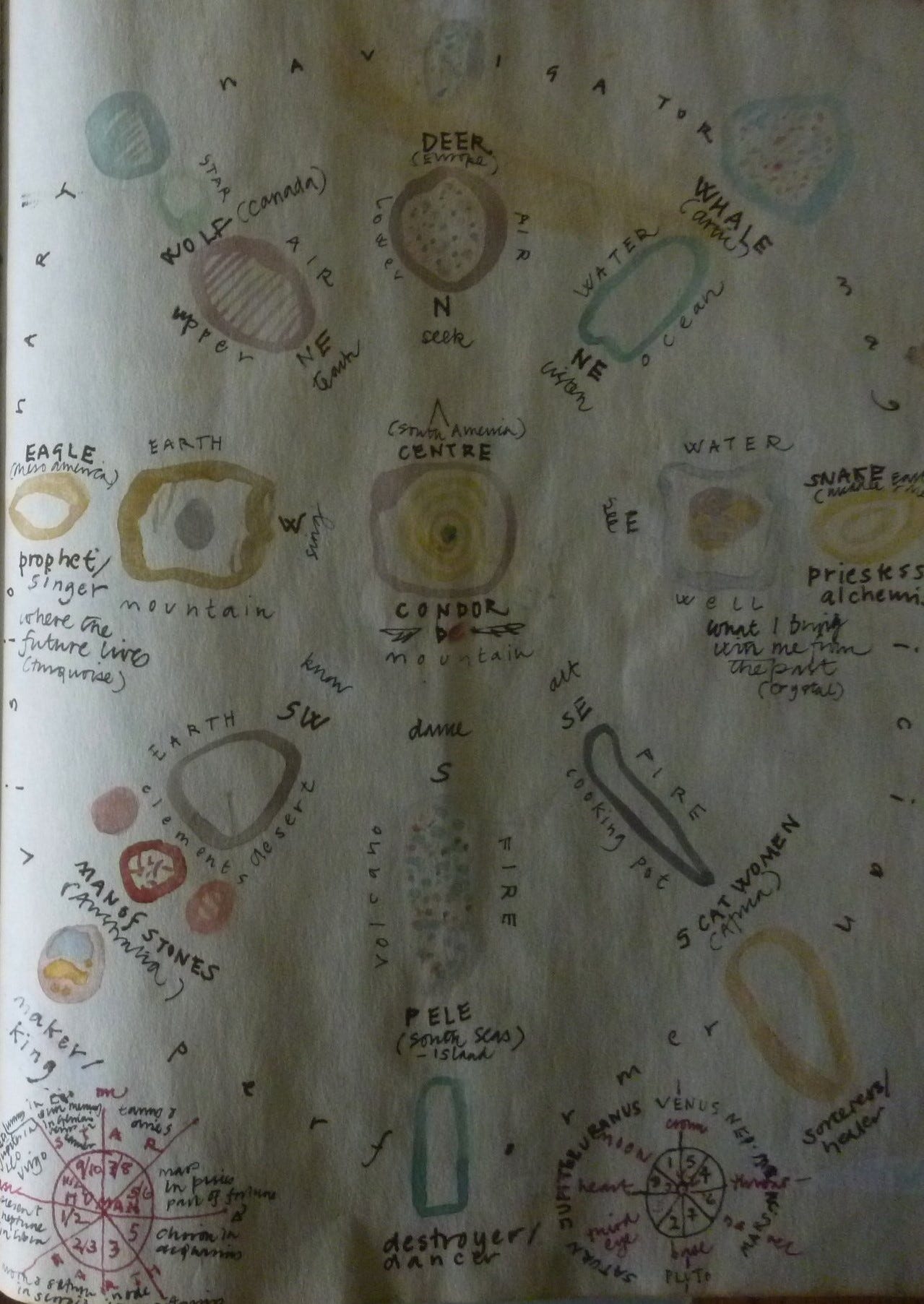
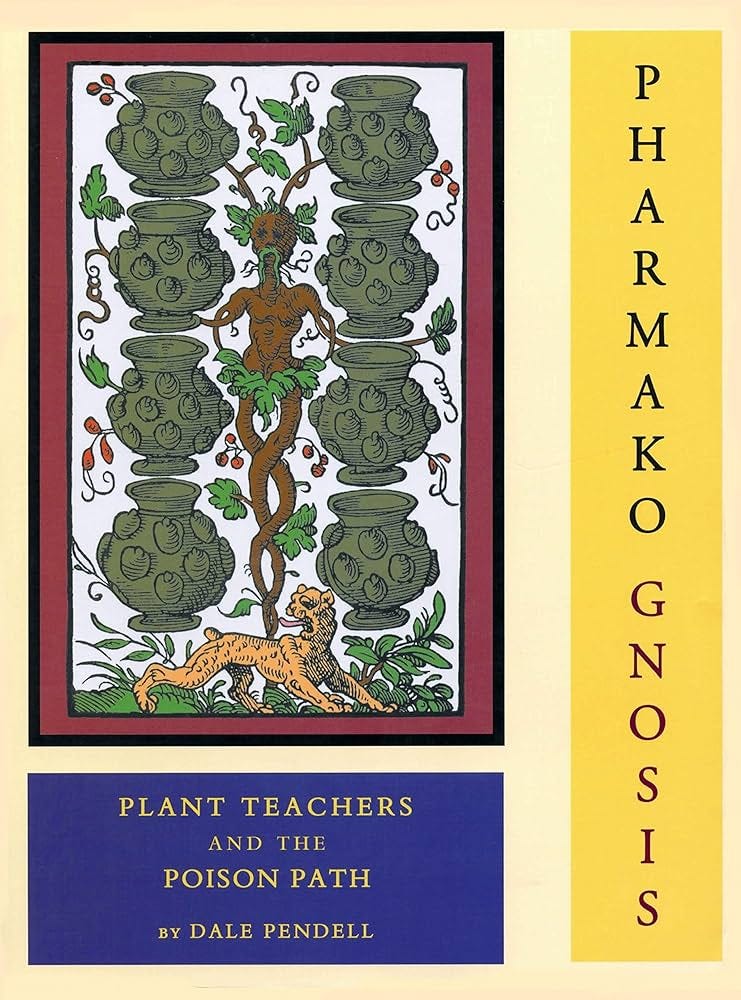
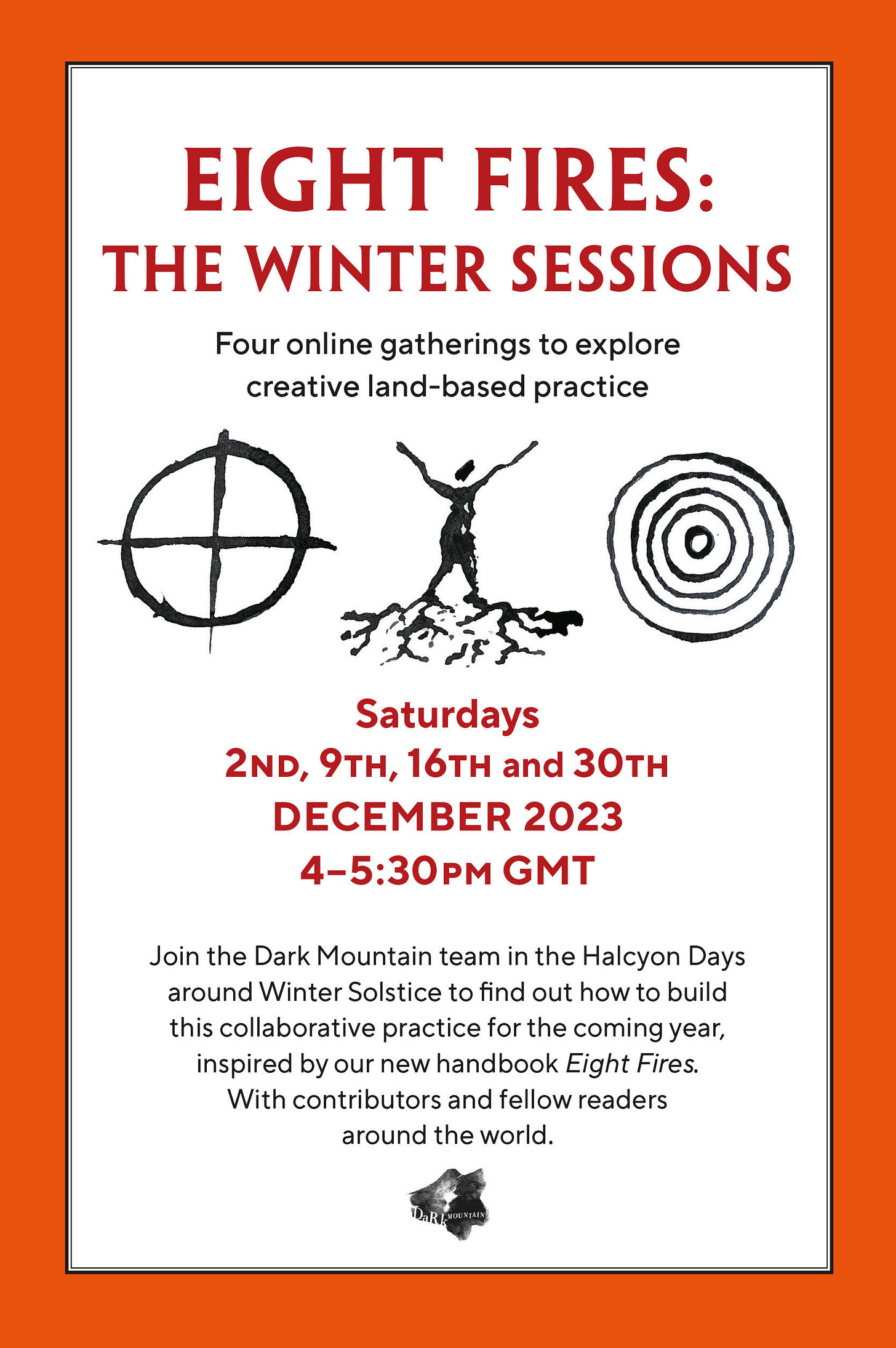
I adore your writing, the way you connect places and times through the plants and the loving, respectful devotion you bring to listening to them and to the land. Thank you, Charlotte, for sharing these teachings!
Hello Serena and many thanks for subscribing. Will be in touch with a link shortly. All best wishes for the new year, Charlotte